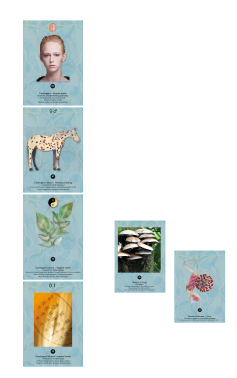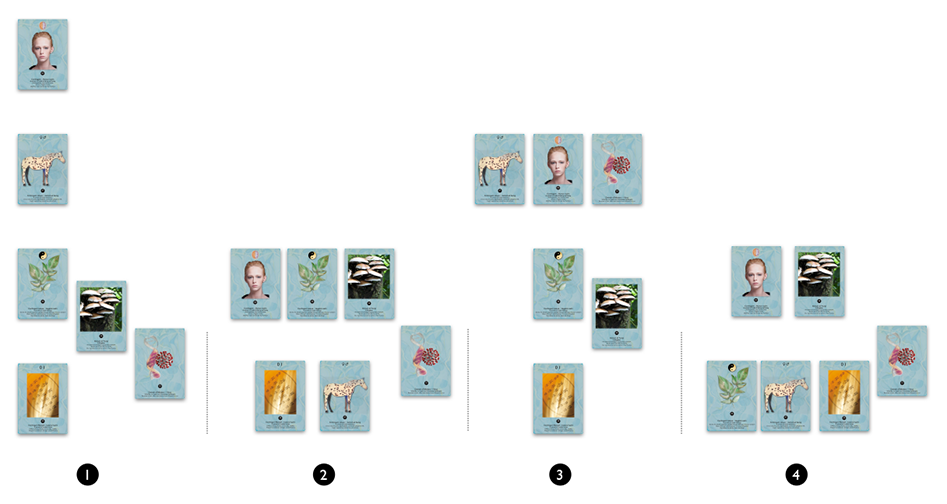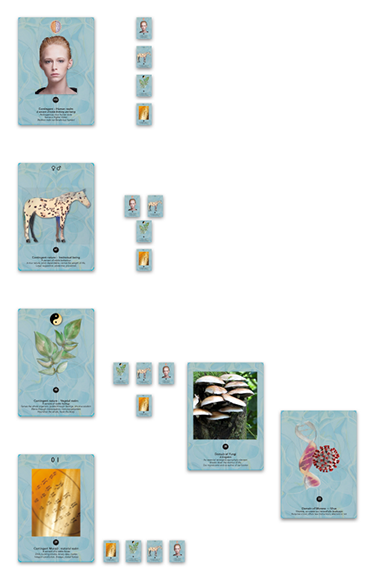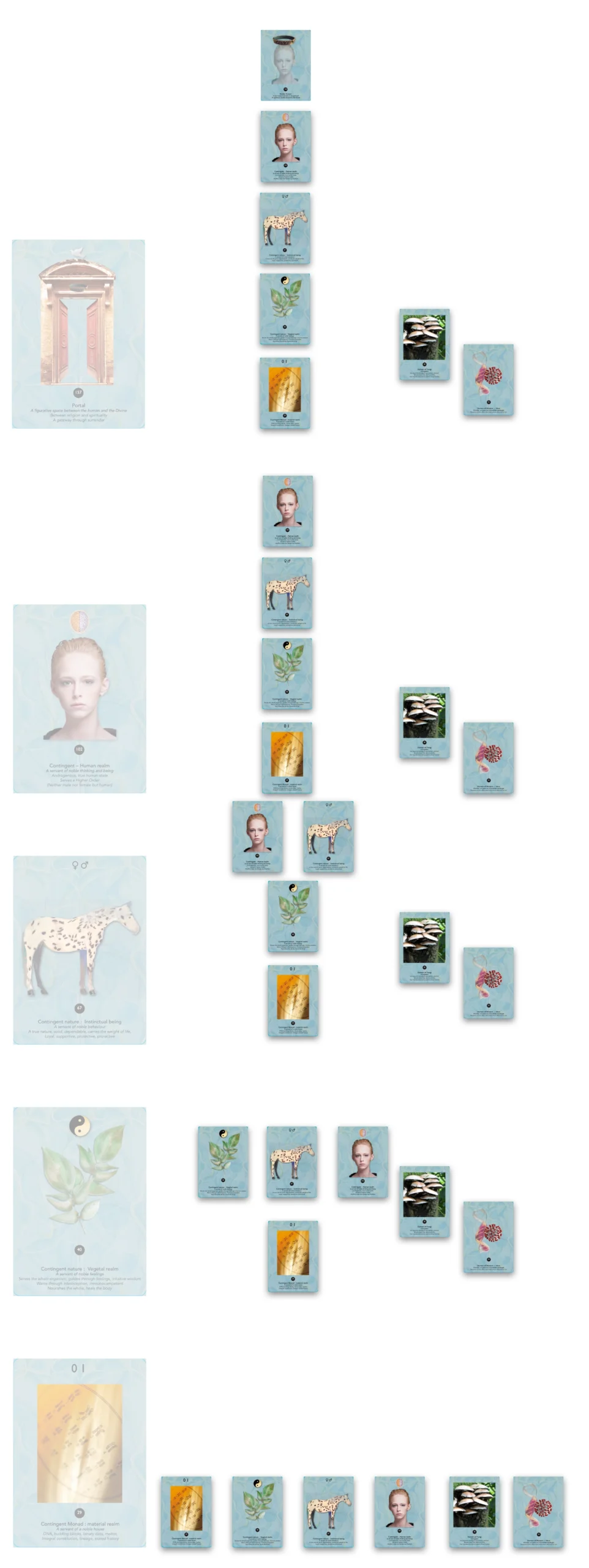Ontology–realms, order and domains
Ontology is the study of being. Simply put, it poses the question of what exists and what is contingent. Contingency implies that things may exist or not depending on specific criteria being met. We have attempted to look at the model of what it takes to become human, and more importantly, a human being, with the emphasis on being. The presupposition that we have taken comes from a long history of the scala naturæ, or the Great Chain of Being. In modern scientific terms, this model is wholly discounted because it misses out on many divergent realms of existence – insects, fungi, parasites, viruses and other branches of evolution. However, we take it as both a literal and metaphorical model in that what does exist is the material human body that has phylogenetically inherited all that has gone before it. Within this material body co-exist a huge and varied population of viruses, parasites, and fungi as elements from their respective kingdoms that reside within us. We also have a vegetative body that, like software, has gone through many evolutionary expansions of function since it was developed in the plantæ kingdom. This vegetative body is the animating life force that brings our body alive, functional in a physiological sense and neurologically alive through its sensory receptors and neurons in its sensitivity to what is happening within and around us.
Further upgrading our physical body is the mammalian cortex and our ambulatory skills, muscles, and joints. The animal kingdom resides in our brain as the cerebellum for movement and proprioception via the whole spinal cord and higher centres, for our muscles and joints to orientate us in space, time, society, and life. It provides superior skills in defence, survival and mating. We possess small but essential nuclei that constantly glean information in the now to compare and contrast past experiences and for us to react to these inputs, but on the oft-mistaken reaction that it is a threat. We have the limbic system, hippocampus, and motor and sensory cortexes, which provide us with all that we do instinctively to go about and survive a previously hostile environment.
On top of all of this is the neocortex, which provides us with creativity separate from survival, multiple languages, the ability to write and create alphabets and communicate to all, the ability to explore and live in all environments, and, of course, the ability to create culture, unfortunately, low—as well as high-brow. Also, a huge part of the central, less archaic brain is our smell brain, the rhinencephalon, where we process instinctual reflex action, emotion and memory and collate experiences.

This model is not unlike the classical triune brain, indicating that we have layers of successive evolution – usually named old– parts of the brain deep within the whole brain itself. Dr MacLean developed this, which has been superseded by the theory that the brain is an adaptive mechanism, in that all mammals have all these same structures, but each is different in proportion and extent. The progression from a ‘reptilian‘ brain to a human is not linear but mostly of proportionally different analogous structures. (For further reading, click here.) This corresponds to our model, which states that this internal order does not usually exist. The realms of activity exist within us all. Still, their order and relationships to each other can be developed out of past (inherited or childhood) or present circumstances, through training, or merely jumbled, mixed up, or dominant.
The meta-model illustrated as a specific rank and order, as above, is that within each realm (of activity)—material, vegetal, mammalian, human—all the organisational structural neurological elements of the brain exist. This new model is called the “Environment of Evolutionary Adaptation” It is said in the paper listed above that there are three adaptive response systems. These are [1] emotion, [2] cognition, and [3] social connection. These three allow for broad strategies that are not necessarily reactive or reflexive but can be tactical to a given situation. However, responses may be varied. As humans, we can illustrate this new understanding through the lexicon of rank and order or the neurological, cognitive qualities that require learning and development. To [1] notice, [2] be aware, [3] be attentive and [4] be mindful and able to [5] submit to higher guidance when appropriate; this is a level of higher consciousness.
We can illustrate much of this adaptive processing due to internal or external environmental dynamics by the following:

- 1—This would indicate a fully adaptive yet ordered and structured neurology that can pause and be mindful of any situation.
- 2—When the human organism has adapted due to an emotional state, having an overgrowth of fungus and resultant altered biome, which may then directly affect human cognition, and whose instincts are held by the reflexive reptilian brain to be still, imprisoned even due to the (historical or present) circumstances. The person has adapted poorly and is in a vegetative or stuck state.
- 3—This human being is held in reflexive (amygdala-driven) reactive, survival-mediated behaviour and is affected by a meme or virus that alters neurological competency and even (latent) pathology.
- 4–Human cognition has been adapted by an overgrowth of fungus, emotion, and psychic energy, displacing the adaptive brain into a non-compliant, inactive, unanimated state, as if comatose, dysfunctional, and emotionally vulnerable.
The premise of our ontological model is that what it takes to become human is that we coexist in realms and domains. The realms could be seen as the activities or functions that we operate from. The above illustrates that. However, we also talk about domains, which include activities and the notion of knowledge. Knowledge is a human passion or drive. It allows us to ascend to grow and evolve into different modes or states. We transcend into distinct domains, albeit we operate from these same realms, although they become more controlled by the higher aspects of who we are.

The above illustrates the idea that our soul evolves from a material human to a feeling-aware human, into an instinctual, assertive, motivated and ambitious human into a human who is fully awake and has their house in order. This is when a human culture becomes possible because thought and creativity are now supported by what’s below rather than dominated by one of the other domains.

Diagram: Domains (knowledge and being) on the left [dimmed out], realms (functionaries–material-human, vegetal-human, instinctual-human, ordinary-human) within each domain
Top card: the human surrenders through the portal into the spiritual world and begins to be imbued with a sense of nobility.
When operating from a particular domain–material, for example–we have all the differing realms supporting us, although they need to become ordered, flexible, and adaptive. This infers that the realms can change their respective position (from our supposed normal) within us for strategy, survival, and adaptation in a particular moment. However, ideally, we need to develop the capacity to restore our house. These material humans are what we might call straightforward, functional, salt-of-the-earth, solid, and dependable (when their respective realms are in the right order). As we evolve spiritually and internally, we move from the outside world into our inner worlds and experiences via the vegetal-human domain. Again, our transformation may be long and arduous; often, it is a domain within which we get stuck and mired in our sensitivities, emotions and feelings. The ascent of the soul–a main consideration of the Great Chain of Being– may take us upward into the mammalian-human domain. This is the realm of ambition, courage, movement, action, manipulation, power, and sexual and gender identities. This is a hard place, and it takes effort, stamina, and patience (a virtue) to emerge from it. Ultimately, we move into our human soul, which is a far bigger presence than what is below, and now it is supported by what is below rather than influenced by the lower realms and domains.
This is achieved through surrender and submission, a precept in all religious and spiritual models, although couched in different words and languages. The ascent of the soul is the primary dynamic of us in the world. However, we mostly forget and place the soul into a comfortable ‘bed’ of an idea, belief or hope or into a proverbial room, often forgetting it. The soul is frequently talked about abstractly because it would appear that few have genuinely tasted their soul. Still, many vehemently defend that we are souls incarnated into a body or that our body houses our soul.